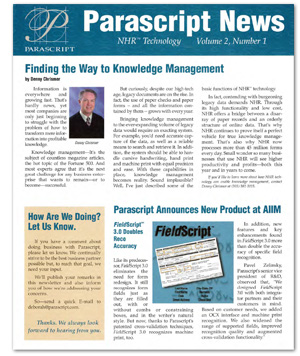 Ever dust off something your company was working on ten years ago and scratch your head in a moment of deja-vu, wondering if anything has actually changed? Heres a scan of a Parascript newsletter, from 1999!
Ever dust off something your company was working on ten years ago and scratch your head in a moment of deja-vu, wondering if anything has actually changed? Heres a scan of a Parascript newsletter, from 1999!
The funny thing is, reading it feels like not much has changed. There have been M&As, (Captiva to name one), new names and faces, but so many of the business challenges faced are the same as what we are discussing today.
In fact, the basic concepts of handwriting recognition havent changed either. For a quick trip back to school, read the 3rd page (Parascript Classroom) to learn about the differences between OCR, ICR and NHR (we lump NHR with ICR, or advanced ICR now). Its good content, and entirely relevant today.
Knowing that our AIIM research suggests that OCR has only 32% penetration and 55% are still re-keying, one is inclined to ask, why such low adoption 13 years later if the business challenge is fundamentally the same?
Here are just two explanations, of which there are many more variables:
1) The business challenge did change in short, the number of inputs organizations want to capture and consolidate have increased greatly. A scanner around every corner, a camera on every phone and a constantly updated datastream enveloping nearly every minute of our lives. Companies never envisioned harvesting a Twitter datastream in 1999. Now it is part of the big data problem.
2) Technology has become more reliable and more accessible. Lower cost of development and deployment, along with higher levels of capability and accuracy have made what was once a niche software for large enterprises accessible to many more organizations of different sizes. It is now cost-justifiable for the mid-market to engage with document automation.
Do you have more reasons? Feel free to comment below.



